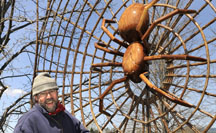May 5, 2011

Skunk River Navy founder and "admiral" Jim Colbert gives directions to his troops. Hundreds of students and volunteers have participated in the cleanup efforts. Photos by Rashah McChesney.
Five questions for Jim Colbert
by Erin Rosacker
Jim Colbert launched the Skunk River Navy in the fall of 1998, as a service project for the BEST freshman learning community (Biology Education Success Teams). Since then, his squadrons of students and volunteers have hauled an estimated 60 tons of trash out of area waterways.
The Basics
Name: Jim Colbert
Position: Associate professor in ecology, evolution and organismal biology
Years at ISU: 23
Education: Iowa State University (B.S., 1978), University of Wisconsin (M.S., 1981; Ph.D., 1985)
What are the biggest, craziest or oddest pieces of junk that were hauled out of the river?
The heaviest piece that sticks in my mind is the tire from a front-end loader, with the rim. It was estimated in the 500-pound range. It probably took 10-12 people just to dig it out and balance it on two canoes. I'm sure it took probably 20 people pulling on a chain to drag it up the hill.
The craziest things we've seen all fall into the port-a-potty category, including a fully intact one. It's everything you can imagine, and even some things you don't want to imagine. It's bicycles, grocery carts, refrigerators and La-Z-Boys. Perhaps the oddest thing we've found was what appeared to be an (open) home safe.

Volunteers interested in getting involved can find out more about the Skunk River Navy online or by email.
Is there a recommended uniform for members of the Skunk River Navy?
I think there is, but not everyone agrees with me. My wife calls it my demented elf outfit. I wear a thin pair of long underwear (synthetic, not cotton), a pair of nylon shorts over that, and a work shirt that will dry quickly. Add a Skunk River Navy cap and a pair of leather gloves and you are a well-accoutered SRN volunteer. What you want are things that are lightweight and will dry quickly. Bad ideas would include sweat pants, flip-flops and jeans.
I always tell the students to shower within 48 hours afterward and to NOT put their clothes into a plastic bag and leave them in the back of the closet. Believe it or not, it's been done in the past. Apparently, that will grow some interesting things.
How many miles of river have you covered since 1998?
We have worked from the Story City park down nearly to where the South Skunk River goes under Interstate 35 -- about 25 miles. We only do 2-3 miles per day and we've done a number of those sections multiple times. Those are places that have lots of legacy trash -- stuff that has been there a long time. We have yet to do a stretch of river and not find any trash. I'd love to work ourselves out of a job.
What is the origin of the Skunk River Navy name?
Obviously, since it's called the South Skunk River, the Skunk River part was easy. The navy part is a direct result of the fact that we use boats -- but they are canoes, not aircraft carriers. We have admirals and captains. We refer to our first-year student volunteers as "river persons, first class." There also is the rank of "rear admiral;" myself and my co-leader (Jim Holtz) ask one of the other admirals to stay at the end of the group to make sure no one is left behind or needs help.
How do you choose what stretch of river to cover?
The first criterion is safety and feasibility (including flow level). The second criterion ... I spend some parts of the summer scouting for the navy -- some people would call it fishing. What I'm looking for is trophy trash. If we can find something that takes a group effort to do, when you talk to people, that's what they remember. The third criterion would be how recently we've been in that stretch.
